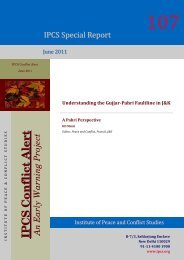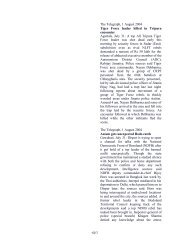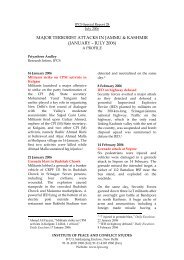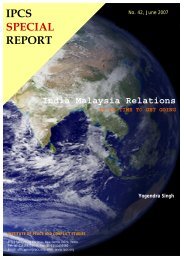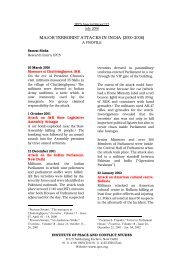India and Southeast Asia: A Personal Narrative from Chennai
India and Southeast Asia: A Personal Narrative from Chennai
India and Southeast Asia: A Personal Narrative from Chennai
Create successful ePaper yourself
Turn your PDF publications into a flip-book with our unique Google optimized e-Paper software.
IPCS SPECIAL REPORT #139, MARCH 2013<br />
area of peace <strong>and</strong> tranquility. What is more, <strong>India</strong>’s two difficult neighbours, Pakistan<br />
<strong>and</strong> China, are not part of the Bay of Bengal Community.<br />
Despite obvious advantages, the idea did not elicit any favourable response <strong>from</strong> the<br />
<strong>India</strong>n Foreign Office for a long time. In a conversation with the author, Amb Ranjit<br />
Gupta, former <strong>India</strong>n Ambassador to Thail<strong>and</strong>, recalled that when he broached the<br />
subject to Amb JN Dixit, then Foreign Secretary, he ridiculed the whole concept as<br />
preposterous. Amb Ranjit Gupta did not give up; he was able to win over the Thai<br />
Foreign Minister to his side. It is well known that the idea of BIMSTEC was officially<br />
suggested by the Thai Foreign Office. It was a good mechanism to combine the “Look<br />
West” policy of Thail<strong>and</strong> with the “Look East” policy of <strong>India</strong>. New Delhi had to fall in<br />
line <strong>and</strong> in June 1988 BIMSTEC (Bangladesh, <strong>India</strong>, Myanmar, Sri Lanka <strong>and</strong><br />
Thail<strong>and</strong> Economic Co-operation) was born. The membership was exp<strong>and</strong>ed in 2004 to<br />
include the two l<strong>and</strong> locked states of Nepal <strong>and</strong> Bhutan. It was also resolved to change<br />
the name of the organization to Bay of Bengal Initiative for Multi-Sectoral Technical<br />
<strong>and</strong> Economic Co-operation. Several priority sectors were identified, but the progress of<br />
BIMSTEC had been very slow.<br />
If BIMSTEC has to attain its lofty objectives, the member states, in letter <strong>and</strong> spirit,<br />
must follow what the Javanese call the principle of Gotong Royong (Mutual Cooperation).<br />
Today regional co-operation occupies a very low priority in our foreign<br />
policy; it must become central to our foreign policy objectives. And when we finalise<br />
our five year plans, a chapter should be included spelling out the details of economic<br />
diplomacy <strong>and</strong> how it will give a fillip to regional co-operation. Then only we will be<br />
able to infuse flesh <strong>and</strong> blood into the concept of regional co-operation (2).<br />
As far as civilizational states like <strong>India</strong> <strong>and</strong> China are concerned, no epoch in history is<br />
complete in itself; it is both a continuation <strong>and</strong> a beginning. Former Prime Minister<br />
Narasimha Rao underlined this basic reality in his famous speech <strong>India</strong> <strong>and</strong> the <strong>Asia</strong>-<br />
Pacific: Forging a New Relationship in October 1994 at the Institute of <strong>Southeast</strong> <strong>Asia</strong>n<br />
Studies in Singapore. The closer relationship which <strong>India</strong> seeks today with <strong>Southeast</strong><br />
<strong>Asia</strong>n countries, as Prime Minister Narasimha Rao underlined, has to be fashioned on<br />
twin foundations – the benign interaction of the past <strong>and</strong> mutuality of interests that<br />
exist at present (3).<br />
In its relations with <strong>Southeast</strong> <strong>Asia</strong>n countries, <strong>India</strong> has several plus points.<br />
Historically Burma, Thail<strong>and</strong>, Cambodia, Laos, South Vietnam, Malaysia <strong>and</strong><br />
Indonesia have been deeply influenced by <strong>India</strong>n political ideas, religion, art <strong>and</strong><br />
language. The spread of cultural influences, leading to the cultural enrichment of<br />
<strong>Southeast</strong> <strong>Asia</strong>n countries, constitutes a glorious chapter in <strong>India</strong>n <strong>and</strong> <strong>Southeast</strong> <strong>Asia</strong>n<br />
history alike. <strong>India</strong>nised kingdoms like Funan, Sri Kshetra, Pagan, Khemer, Sri Vijaya,<br />
Sailendra <strong>and</strong> Majapahit; the familiar Indo-Sanskritic vocabulary in Thai <strong>and</strong> Bahasa<br />
Indonesia; architectural monuments like Angkor Wat, Pagan, Borobudur <strong>and</strong> Lara<br />
Djonggrong; literary masterpieces like Ramkien, Amaramala, Arjuna Vivaha <strong>and</strong><br />
Bharata Yuddha; the Wajang Kulit based on the Ramayana <strong>and</strong> Mahabharata themes;<br />
the living <strong>India</strong>n traditions in the isl<strong>and</strong> of Bali – all these bear testimony to the<br />
courage <strong>and</strong> zeal of <strong>India</strong>n princes, priests, poets, merchants <strong>and</strong> artisans <strong>and</strong> the<br />
ingratiating <strong>and</strong> assimilable qualities of the <strong>Southeast</strong> <strong>Asia</strong>n peoples.<br />
Historically Burma,<br />
Thail<strong>and</strong>, Cambodia, Laos,<br />
South Vietnam, Malaysia<br />
<strong>and</strong> Indonesia have been<br />
deeply influenced by <strong>India</strong>n<br />
political ideas, religion, art<br />
<strong>and</strong> language. The spread of<br />
cultural influences, leading to<br />
the cultural enrichment of<br />
<strong>Southeast</strong> <strong>Asia</strong>n countries,<br />
constitutes a glorious chapter<br />
in <strong>India</strong>n <strong>and</strong> <strong>Southeast</strong><br />
<strong>Asia</strong>n history alike.<br />
Not much work has been done by <strong>India</strong>n scholars on the impact of culture in <strong>India</strong>n<br />
foreign policy. In fact, as far as <strong>Southeast</strong> <strong>Asia</strong> is concerned, the fascinating encounter<br />
among Indigenous, <strong>India</strong>n <strong>and</strong> Chinese influences deserves deeper study <strong>and</strong> sharper<br />
focus. Equally relevant <strong>India</strong> has not been able to exploit to the full the advantages that<br />
05








